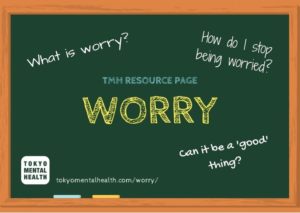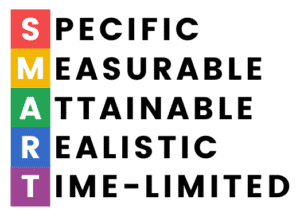Tokyo Mental Health is here to support you and provide you with the help you need.
What is worry, exactly?

We have all felt worry at some point in our lives but, for some, their worries can be a real disruption. So, what do we mean by worry? And why do we worry?
To understand worry we have to travel back many years into human history and consider the purpose of worrying. When humans were struggling for survival, it would make sense to consider the possible outcomes of a situation and plan accordingly. However, in modern times, we often worry about non-life threatening situations and yet it can feel like we’re in real danger. In order to understand why we might feel that way, let’s look at what research says about what worry is:
“worry is elicited in response to anticipated threat” (Borkovec, 1985)
“worry is … the cognitive component of anxiety” (Borkovec, 1985)
“worry is mainly concerned with personal and emotional threats to self” (Mathews, 1990)
“When I am worrying, I am mostly engaging in thought or talking to myself. This thinking, triggered by internal or external cues that signal danger, primarily concerns the future, and this future-oriented thinking involves the anxious anticipation of, and mental attempts to avoid, the many negative events that I think or that I imagine might happen based on the threatening meaning of the cues that initiated the worrying” (Borkovec, 2002)
So, in simple terms, worry is a thought response to perceived danger in our external or internal environment. Additionally, these thoughts are often concerned with the future rather than the here and now, despite being triggered by our immediate environment.
Nowadays, we often seem to worry about things that are outside of our control. A worry tends to be about something that we can imagine but have no control over how it will turn out. Paradoxically, that is exactly the reason that many of us worry – because we cannot do anything about it other than to think of all the possibilities that could happen. When we worry, we imagine scenarios and ask ourselves ‘what-if’. This ‘what-if’ spiral can be very misleading and we end up thinking about the worst possible outcome in a situation. It might seem like a never-ending cycle from which we cannot break free.
Table of Contents
Can worrying be a ‘good’ thing?
Well, surely there is a reason that worry has evolved over time so there must be something ‘good’ about worrying? van der Heiden and ten Broeke (2009) believe “worry can be seen as a continuum, ranging from adaptive worry to maladaptive worry”.
Adaptive worry is mild and can be a motivator to identify and achieve goals. An adaptive worrier is able to withstand the discomfort of uncertainty about the future and use worry as part of problem solving or finding goal-focused solutions. Worry becomes maladaptive when the worrier becomes focused on the potential negative outcomes of a situation and attempts to find solutions to all the possibilities that arise in their mind. Some believe that maladaptive worrying is a form of avoidance i.e. procrastination. This might explain why many people who worry excessively find it difficult to complete tasks.
Thus, worry isn’t all bad. It can work in your favor as it can be a call to action, but it can also become exaggerated to a point where it is maladaptive.
Are there different kinds of worries?
According to Meares & Freeston (2015) there are two kinds of worrying: “real-event worry” and “hypothetical-event worry” .
- Real-event worry occurs when something has just happened, for example receiving a credit card bill, and starting to worry about whether, due to financial constraints, you can pay it on time.
- Hypothetical-event worry, on the other hand, is the kind of worry referenced above when we tend to focus on the future and possible outcomes for an event that hasn’t occurred – the ‘what ifs’.
What both these kinds of worry have in common is the idea of uncertainty and the unknown. But we’ll explore more about that a little later in this article!
Rest assured, there are certainly ways we can manage our worries. We cannot completely erase them but we can find ways to stop them from interrupting our daily lives.
Should I be worried about worrying too much?
Have you ever thought that you worry too much? Do you end up worrying about worrying? Many of us are concerned about how much we worry. Of course, worry is just one of many everyday human experiences and is ‘normal’. However, worry can become so extensive that it can become a mental health problem. So, let’s look at the difference between worry and Generalized Anxiety Disorder (GAD).
What’s the difference between worry and Generalized Anxiety Disorder (GAD)?
If I worry a lot, does that mean I have an anxiety disorder?
If you are concerned about how much you worry everyday and it is starting to impact your daily life, then it would be a good idea to seek help from a therapist or psychiatrist.
But, how do you know when your worry is interfering with everyday life? You can get a sense of the signs to look out for by referring to the Diagnostic and Statistical Manual of Mental Disorders 5 (DSM-5) (American Psychiatric Association, 2013) diagnostic criteria for Generalized Anxiety Disorder:
General Anxiety Disorder – Diagnostic Criteria
- A: Excessive anxiety and worry (apprehensive expectation), occurring more than not for at least 6 months, about a number of events or activities (such as work or school performance)
- B. The individual finds it difficult to control the worry.
- C. The anxiety and worry are associated with three (or more) of the following six symptoms (with at least some symptoms having been present for more days than not for the past 6 months)
- 1. Restlessness or feeling keyed up or on edge.
- 2. Being easily fatigued
- 3. Difficulty concentrating or mind going blank.
- 4. Irritability.
- 5. Muscle tension.
- 6. Sleep disturbance (difficulty falling or staying asleep, or restless, unsatisfying sleep)
- D. The anxiety, worry, or physical symptoms cause clinically significant distress or impairment in social, occupational, or other important areas of functioning
These are just a few of the diagnostic criteria for GAD. Of course, these symptoms can occur with other health issues so please be sure to see a doctor if you are concerned about any physical symptoms.
The most common sign of GAD is related to the content of your worries, most often in relation to family, health, finances, school or work. Do you find yourself worrying over every detail? Do you worry almost constantly? And has it been going on for a long period of time? In this case, it is likely that you might suffer from anxiety. If you find that you tend to only worry about ‘big’ things, and it occurs over only a short time period, then you might be dealing with a non-clinical level of stress.
So, now we understand a little more about what worry is and how it can impact our lives. Let’s look at how we can manage our worries.
the client masters all the goals or the current treatment plan doesn’t work anymore.
How do I stop worrying about things?
Great question! I think everyone must have asked themselves this at least once in their life! The nature of worries are that they are involuntary so it is not as easy as just deciding to worry less. Dealing with excessive worrying can require different approaches…
Let’s look at some ways we can manage our worries but let’s also be mindful that everyone is different and the below approaches might not work for everyone.
Method 1: Goal-Setting using S.M.A.R.T

Meares and Freeston (2015) suggest setting goals using the SMART method. Your goals should be Specific, Measurable, Attainable, Realistic and Time-limited. I’m sure we have all tried to accomplish a task that has been so overwhelming and we’ve given ourselves only a short time to do it. Obviously, that is not realistic, and if we try to do many things at once, then it is likely that we’ll become easily overwhelmed. So, try starting with one specific task, set an appropriate deadline to complete it, and find a way to record your progress (e.g. a planner). This way you are setting yourself up for success from the start. If you need to adjust your goal along the way that’s okay too, because sometimes we don’t always know how long or how big a task can really be until we start it. That’s why the SMART method is a good way of approaching goals that can make them seem manageable – reducing any uncertainty and therefore any worries we might have.
Method 2: Improve Your Tolerance of Uncertainty
It’s a lot easier said than done but a large amount of our worries come from being uncertain about the future or outcome of a situation. There are times when we can think ahead and we can reduce the likelihood of bad outcomes but most of the time there is actually little we can do until the event occurs. So, in order to reduce our worry, we have to come to accept uncertainty and find a way to feel okay with ‘not knowing.’
Here are questions you can explore to come to terms with uncertainty:
- What is possible to know about my situation?
- Is it possible to know the outcome 100%?
- Why do I want to know the outcome?
- What is my worst fear in this situation?
- Do I have any rules or ways of thinking that prevent me from staying in the present? (e.g. ‘It’s better to be safe than sorry’)
- Has anything bad happened in a similar situation that is making me worry about my current situation?
Once you explore some of these questions, you might notice underlying themes in the way that you are thinking and behaving. Take some time to reflect on them and think about how you can change your thinking in that moment. Writing down your answers is a great way to keep yourself from overthinking, and if you have a physical record of your thoughts you can return back to it at any time for reflection. It might be a good idea to use the S.M.A.R.T technique mentioned above after you have taken some time to reflect.
Method 3: Cognitive Behavioral Therapy
Another option is to seek help from a therapist. It can be difficult to implement changes in your life on your own and can often cause more stress without support. If you feel like it would be too hard to make changes on your own, or you’re not really sure where to start, then Cognitive Behavioral Therapy (CBT) might be a good option for you.
CBT is an approach that focuses on how our thinking affects our behavior. Cognitive Behavioral therapists will try to help you challenge your current ways of thinking, which are often unhelpful and make us feel stuck. They often do this by completing tasks in the session that highlight how you are thinking and behaving. Additionally, they might give you ‘homework’ to complete between sessions. Usually, your therapist will guide you through the homework task, with the goal being to develop an awareness of your thoughts and behaviors, and to recognize how you can change them to benefit your mental wellbeing.
Method 4: Mindfulness-Based Approaches
There is a growing amount of research into mindfulness and its effect on reducing symptoms of anxiety. It has been suggested that mindfulness is a useful intervention, especially to prevent relapses into clinic levels of anxiety (Hofmann et al., (2010). Mindfulness uses directed attention, breathing and guided imagery to reduce stress. How? By focusing on the present moment and noticing how you are thinking, feeling and sensing.
Mindfulness might sound counterintuitive when focusing on thoughts is often the start of the worry process. The difference with mindfulness is that we do not impose any judgement or interpretation. In mindfulness, it’s OK if negative thoughts pop up, because they will, but we do not focus our attention on the thought, rather acknowledge it and notice other thoughts or feelings that pop up. You could imagine it like saying hi to your neighbor in passing; you don’t stop to talk with your neighbor, you acknowledge them and you keep walking.
If you want to learn more about mindfulness, our therapists can guide you through it. At Tokyo Mental Health, we also offer mindfulness-based interventions such as Mindfulness-Based Cognitive Therapy (MBCT) (Segal, Williams, & Teasdale, 2002). We often use this approach to prevent relapse and the aim of the therapy is to build up resilience through mindfulness practices, which can be used as coping strategies for stress and worry.
It’s not me who is worried, it’s my child. What do I do?
Anxiety in childhood can be different to what we, as adults, experience. We should be mindful of thinking about childhood anxiety only through a diagnostic and symptomatic lense. While it is useful to consider common signs of anxiety in children, it is most beneficial to consider how anxiety might affect your child’s daily life and the behaviours they exhibit. According to the book ‘The Opposite of Worry…’ (Cohen, 2013), here are some signs to look out for:
- Fidgeting, restlessness or jumpiness
- Clumsiness, awkwardness, physically timid/stiff
- Shortness of breath or stomach aches
- Dissociation or zoning out
Children usually express anxiety in a physical way since they are not equipped with the tools yet to manage their emotions. So, it is important to recognise that some behaviours your child is showing, which might seem difficult to deal with, are actually signs that they are having difficulty managing their emotions.
But what do children have to worry about? You may be thinking that children don’t have to worry about a lot of things; they don’t have bills to pay or jobs to go to. However, children do have very real fears and worries and the first step to helping your anxious child is to acknowledge their feelings and to show them that you understand. Some common childhood anxiety and fears include: separation anxiety, social anxiety, fears about real or imagined threats to their safety, worrying about the future (what-ifs), and fears about life and death.
Cohen (2013) suggests several ways to help your anxious child. The key ideas from their book are first, to validate your child’s feelings and then help to reassure them. Reassurance can take on many different forms but a great way to start would be to teach your child relaxation techniques. One popular method for relaxation would be to use mindfulness – a breathing technique that helps to calm the nervous system when it is on high-alert.
Cohen (2013) also notes that play is a vital part of helping children to overcome their anxieties. For young children especially, they do not have the verbal skills to tell you what is wrong but often they can show you during play. Play is a great place for children to process their fears in a safe and controlled environment.
If you’re not sure how to teach your child relaxation techniques or you don’t know how to help them through play, then Play Therapy might be a great option to consider. Your child’s therapist will use play to help your child process their feelings and can teach your child relaxation techniques in the session. Usually, your child’s therapist will offer advice on how you can continue to implement these techniques at home.
I’m still not sure, what should I do?
If you’re feeling overwhelmed for yourself or your child, please contact us at Tokyo Mental Health. We have a range of therapists from a variety of backgrounds who can help you to decide the best course of action. We are happy to answer any questions about therapy and what services we offer.
Tokyo Mental Health’s counseling and psychotherapy services are offered in Tokyo, Okinawa (children only), and online/telehealth.
References
- Borkovec, T. D. (1985). Worry: A potentially valuable concept. Behaviour research and therapy, 23(4), 481-482.
- Mathews, A. (1990). Why worry? The cognitive function of anxiety. Behaviour research and therapy, 28(6), 455-468.
- Borkovec, T. D. (2002). Life in the future versus life in the present. Clinical Psychology: Science and Practice, 9(1), 76-80.
- van der Heiden, C., & ten Broeke, E. (2009). The when, why, and how of worry exposure. Cognitive and Behavioral Practice, 16(4), 386-393.
- Meares, K., & Freeston, M. (2015). Overcoming Worry and Generalised Anxiety Disorder (2nd ed.).
- American Psychiatric Association. (2013). Anxiety disorders. In Diagnostic and Statistical Manual of Mental Disorders (5th ed.).
- Hofmann, S. G., Sawyer, A. T., Witt, A. A., & Oh, D. (2010). The effect of mindfulness-based therapy on anxiety and depression: A meta-analytic review. Journal of consulting and clinical psychology, 78(2), 169.
- Segal, Z. V., Williams, M., & Teasdale, J. (2018). Mindfulness-based cognitive therapy for depression. Guilford Publications.
- Cohen, L. (2013). The Opposite of Worry: The Playful Parenting Approach to Childhood Anxieties and Fears. Random House Publishing Group.
